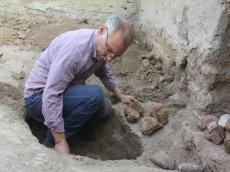|
|
TODAY.AZ / Society
Rare antique objects found in Shabran
13 November 2017 [14:00] - TODAY.AZ

By Azernews
By Aygul Salmanova
Unique archeological samples have been found during excavations near the Aygunlu village of Azerbaijan's Shabran region.
The most exciting archaeological findings from the fourth, fifth and sixth squares have been obtained during the excavations at the Chaqqaliktype I settlement in the Chaqqall?ktepe monuments complex located in the Aygunlu village of Shabran region.
Head of the department, PhD in history Safar Ashurov said that quadrangular, circular and semi-constructed buildings built of bricks were found and cleaned from the natural soil cover on the layers of the research squares.
“In the center of some of the plinths there are oval shaped rectangular barges, economic wells, remains of one or two handle cubes, circular holes with numerous flint stone pieces in several places and circular holes placed in the center of the quadrangular brick. Numerous bone samples still attract attention in the archaeological materials obtained as a result of the research. Most of them are made of needles and awls used in needlework,” Ashurov noted.
Among discovered ceramic products, there are also samples of classical Kura-Araz culture, as well as of the northern-eastern regions of Azerbaijan and Dagestan. Some of the ceramic products found in this monument are believed to belong to more archaic - chalcolithic periods.
“Stone, bone, pottery samples of the Gogolitta plateau are typical for the Bronze Age monuments of the north-eastern region of the Caucasus. Similar materials of this kind are found in Sarkastepe in Khachmaz region, Velikand in Dagestan, Kabaz Kutan and others.
Interestingly, metal products and related materials are not observed, Ashurov added.
“Originally, the monument could be referred to the end of the 7th millennium AD and the beginning of the III millennium. Two more settlements have been identified in this area in 2017, and thus the number of first bronze monuments to the complex has reached five.”
Ashurov said that the second research object of the expedition was Almastapa monument located 115 meters above sea level on the right side of the Samur-Absheron canal above Gandov village on the road to Leyti village.
“The part of the monument to the sowing area has been destroyed due to agricultural activities and the ruins of the walls, formed by a strong burning layer, have emerged. In this section there are two construction sites in the excavation area. The first layer is strongly fragile, and archaeological materials are mixed,” historian notes. “On the second layer, numerous stubble stones, and the remains of the house were discovered where pottery products of various sizes and shapes were found. Observation shows that this part of the monument was burnt after a strong attack and the residents left the house without taking anything.”
The ceramic products obtained from the house differ from each other according to their composition and shape. No traces of cartilage have been observed in any of them.
Based on the analysis of collected materials and excavations, it is possible to refer the Almastapa monument to the ancient period (about 6th-4th centuries BC).
Works on reproduction of found artifacts (pottery, bone tools, etc.) are being carried out and their graphic design, comparative-analytical analysis of the obtained materials is being conducted.
/t_shabrannn1.jpg)
/t_shabrannn2.jpg)
/t_shabrannn3.jpg)
/t_shabrannn4.jpg)
/t_shabrannn5.jpg)
/t_shabrannn6.jpg)
URL: http://www.today.az/news/society/166733.html
 Print version
Print version
Connect with us. Get latest news and updates.
See Also
- 27 August 2025 [14:49]
Azerbaijani media delegation visits NATO headquarters - 27 August 2025 [10:00]
Aghdam welcomes 370 returning IDPs under state resettlement program - 26 August 2025 [15:42]
Smuggling attempt from Iran to Azerbaijan prevented at border - 26 August 2025 [12:43]
Delegation of prosecutors from CIS and neighboring countries visits Shusha and Khankendi - 26 August 2025 [11:02]
Air transport revenues decline in first half of 2025 despite passenger growth - 26 August 2025 [10:41]
International conference on cybernetics and informatics kicks off in Baku - 26 August 2025 [09:19]
Leyla Aliyeva shares video on birthday of First Vice-President Mehriban Aliyeva - 25 August 2025 [12:43]
New DOST Center opens in Kalbajar to provide social services - 25 August 2025 [11:21]
Azerbaijan simplifies visa procedures for Formula 1 foreign guests - decree - 23 August 2025 [11:55]
Participants of 2nd International Youth Forum on Multiculturalism visit tomb of National Leader Heydar Aliyev and Alley of Martyrs
Most Popular
 Radicals have invented new enemy for Iran
Radicals have invented new enemy for Iran
 Research Center: Peace agreement opens historic new page for S Caucasus
Research Center: Peace agreement opens historic new page for S Caucasus
 President Ilham Aliyev receives UK Minister of State for Europe and North America
President Ilham Aliyev receives UK Minister of State for Europe and North America
 Human remains discovered in liberated A?d?r? district
Human remains discovered in liberated A?d?r? district
 ANAMA: Nearly 1,500 hectares made safe in demining push
ANAMA: Nearly 1,500 hectares made safe in demining push
 Court in Baku continues trial of Armenian-origin individuals accused of war crimes
Court in Baku continues trial of Armenian-origin individuals accused of war crimes
 Expired ammunition to be destroyed in Pir?k??kül settlement
Expired ammunition to be destroyed in Pir?k??kül settlement
